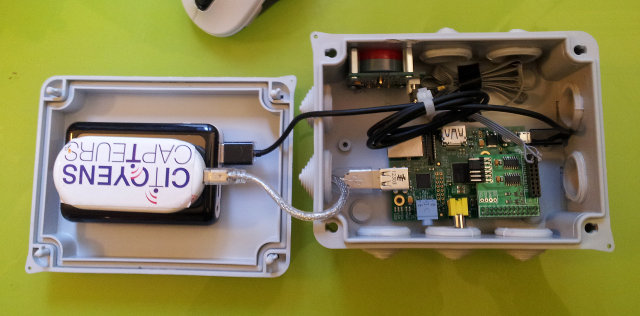“Le Labo Citoyen” is a recently founded French non-profit organization aimed at “promoting and experimenting with innovating and free technologies for the citizens and the environment”. Their first project is to gather pollution data (NO2, O3, and SO2 levels) in Paris using 2 (soon to be) open source components:
- Gasser – Self-contained mobile sensor currently powered by the Raspberry Pi
- ThingStream – Open source IoT datastore which should be similar to iDigi Cloud, except you can just store data in your own server or on “Le Labo Citoyen” servers.
Gasser has four main parts:
- Sensor(s) – Alphasense B4-series sensors (black and red component in the top left of the main box) with accuracy of up to <10 ppb (parts-per-billion). Cost: ~110 Euros. They currently only use the NO2 (nitrogen dioxide) sensor.
- ADC & Computer – Raspberry Pi (Cost: ~30 Euros) & Delta-Sigma ADC (Cost: ~30 Euros).
- Communication Medium – Huawei E220 GRPS USB dongle (White dongle on the left side). Cost: ~35 Euros. This is optional as Ethernet, Wi-Fi or writing to an SD card could also be used to gather data.
- Power Supply – 8Ah USB Battery Pack (Black box on the left side). Cost: ~30 Euros.
The Raspberry Pi may be overkill (in terms of processing power and possibly cost) for this application as the board just takes in information from the open-source delta-sigma ADC and sends data to the ThingStream server via a 2 Euros/month GPRS connection or writes it to the SD card. The battery can last 5 to 6 hours on this system which seems very low considering the size of the battery, and I assume some optimizations could eventually be performed on the system to allow several days or weeks of operations depending on the sampling rate and server communications frequency.
As the project is open source (hardware and software), the developers expect to eventually release a Raspbian image running the necessary scripts to gather and process the data. Thingstream source code is still very early beta, and not open to the public. But if you want to participate as a tester or developer, you can contact Le Labo Citoyen by email at contact <@t> labocitoyen.fr.
As the casing costs 10 Euros, so the total BoM cost for the hardware shown above is about 255 Euros (~$330 US). This is version 2 prototype and costs should go down eventually. If you live in country with no VAT and source the components from Chinese shops, it should be possible to get this hardware for less than $250 US, and even less than $200 is your scrap the USB battery pack and the GPRS modem.
You can find further information about the Gasser on Labo Citoyen Wiki and their IoT server on ThingStream.com.

Jean-Luc started CNX Software in 2010 as a part-time endeavor, before quitting his job as a software engineering manager, and starting to write daily news, and reviews full time later in 2011.
Support CNX Software! Donate via cryptocurrencies, become a Patron on Patreon, or purchase goods on Amazon or Aliexpress





China’s where they really need these. The US Embassy in Beijing monitors pollution, and the data they publish is way higher than the Chinese government’s. I stupidly decided to walk a couple of km along Chang An Jie, and felt quite ill for a couple of days. Day after day it must be really bad for people.
中国人这是一种用树每派的自动测试环境污染器。
I think, the same work can be done using an arduino or msp430. And the MSP430 will run for like many months on that same battery pack. What they’re doing here is shooting an ant with a 50 caliber rifle.
@dragunov
You’re right. I assume they’ll eventually have a board with a micro-controller with built-in ADC, USB host and OTG. But the Raspberry Pi is an easy platform for prototyping, and for GPRS support for example, it’s mostly plug & play in Linux. I’m not sure it’s so easy (and cheap) with an MSP430 board or Arduino.
@cnxsoft
GSM Modules like SIM900 and SIM300 are the most basic and low cost gprs modems available, for around 23 USD as a TTL interface board, 5V and 3V3 tolerant. That just leaves us for a mcu, which can even be a cortex m3 or m4, for its higher resolution adc. or an external adc with mcu like msp430. I understand its easier to prototype with rPi, but if requirements are like just sensor data transmission, either RTOS should be used, or a mcu, which can guarantee data delivery. Plus, the wonderful GPU on the rPi is going to a waste like this 😀